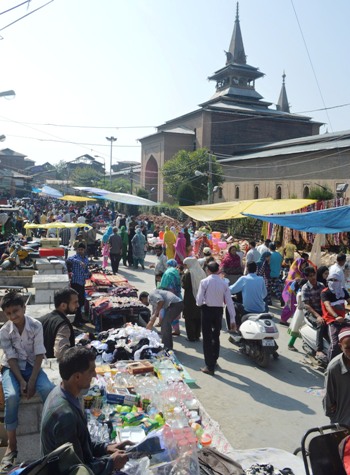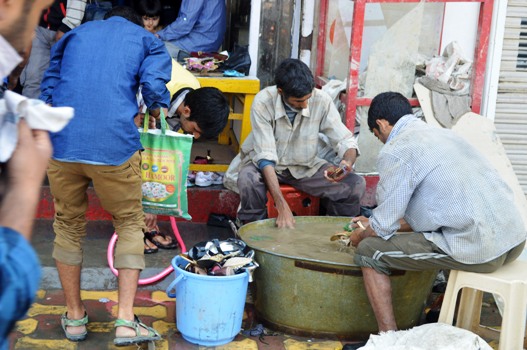
With the major business streets of Srinagar in Lal Chwok, Jawahar Nagar, Dalgate and Karan Nagar devastated by the historic flood, people see the ‘old city’ as the only address for shopping. Safwat Zargar spent a day in the busy markets of the ‘down town’ to argue if trade in Srinagar is returning back to its roots?
On the front side of the compound wall 15th century king Budshah’s tomb at Maharaj Gunj, a young lady, hand in hand, with her three-year old son is walking past a display of bright coloured shoes. Shahida has come from Dalgate to buy apparels and shoes for her son, Burooj.
“You can’t refute the desires of children,” Shahida says, adding “otherwise, there is very less to celebrate this Eid.” Since her marriage, five years back, Shahida, a government employee, has shopped for Eid at Lal Chowk, but this season, nature seems to have broken her habit.
Kashmir is in mourning and Eid is a day far. With Srinagar’s heart, Lal Chowk, weeping mud and dust, the old city or Shahr e Khaas, a week before Eid, is witnessing the festival buzz. While floods washed away the rush of Lal Chowk seems, it is old city’s narrow lanes and streets, bustling with traffic and people.
The two, century-old markets – Maharaj Gunj and Jamia Masjid – are the prime attractions for shoppers. Circled around the archetypal dome of mother’s tomb of Sultan Ghiyas-ud-Din Zain-ul-Abidin’s, well known as Bud Shah, on the banks of Jhelum, floods seem to have livened up Maharaj Gunj’s past glory for now. Known for textiles, spices and marriage items, Maharaj Gunj, in past, would have everything for everyone. It was hard to imagine for a citizen of old city to buy anywhere except Maharaj Gunj.
Over the years with city expanding “un-naturally” and haphazardly to upper areas in flood basins, it triggered the migration of better economic class. The old city dwindled into a myth. For many living in the posh-neighbourhoods and housing colonies, downtown became synonymous with protests, backwardness and stone-pelting. Politics dominated the air but businesses struggled. Now, with floods having ravaged all the new and mostly peaceful markets and destroying stock, people are now flocking back to the old city.
82-year old Hajira of Kadi Kadal still recalls the pinnacle days of Maharaj Gunj to her grandchildren. Young, Hajira, with lunch and fresh curd in a copper jug in her hand, would navigate through crowds of shoppers, vendors and carts men, to reach Zaina Kadal where her father had a jewellery shop. “There is hardly that kind of rush and business now,” she says. “I haven’t been there for years.” However, Hajira believes “it would be beautiful if the grandeur and finery of the old city comes alive again.”
President, Gada Bazar, Maharaj Gunj Traders Association, Nisar Ahmad feels that the damage to Lal Chowk and other uptown area markets have stirred up sales in old city markets. “For last few days, we are realizing the upward trend of new customers visiting our shops. Though, the overall market is sunken but people, with whatever need and money they have, are thronging markets,” he says. “Most of the sales are compulsive sales.”
On the other hand, Fayaz Ahmad, owner of Janta Bakers at Aali Kadal, one of the best bakeries in old city, says people from places outside downtown might be turning in numbers in the old city markets but the average sales are down. “It is as if there is an implicit understanding of spending less. My sales are down by 70 per cent as compared to the previous year,” he says.
Fayaz also says there is indirect shopping taking place this year. “Relatives of flood affected areas are also buying, though in very less quantity, for their flood affected friends and relatives. It includes all those families who are putting up at their relatives’ homes’ in old city.”
The Nalla Mar road, once a water canal of Jhelum and now a two-way macadamized road, cuts the city into two halves. While the Maharaj Gunj market flurries with wholesale dealing mostly, Jamia Masjid market retails all the items ranging from readymade garments to kitchen items.
At one of the gates of Jamia Masjid, Tariq Ahmad, who owns a sprawling showroom of crockery, kitchen and household items, a lady from Raj Bagh is checking rates of the plastic water buckets. “Ninety per cent of my business from last week has been from the people belonging to flood affected areas. They usually look for water buckets, jugs, wipers, mops; to clean their homes,” Tariq says.
We are witnessing huge rush of customers, says Tariq, but we aren’t selling items beyond a price of few hundred rupees. “On Eid, a customer would prefer to buy expensive items. Last Eid, a customer won’t step out from my shop without spending 3-4000 rupees, at present, 500 rupees is a blessing,” he says.

Noted poet and historian, Zareef Ahmad Zareef, believes the trend is an indication of city returning back to its roots but more than that it also evidences the quality of city planning and development of towns. “Old city stretched from Habba Kadal to Safa Kadal – city of seven bridges – and the quality of city planned by British engineers is still in front of us. What happened to Lal Chowk and other surrounding areas raises many questions about the quality and procedure followed in planning,” Zareef says.
Zareef who lives on the foothills of Koh–e–Maraan while recalling past says Maharaj Gunj used to be a wholesale market, its another arm, Gada Bazar, sold retail items, Bohri Kadal was a fruit and vegetable market, transported there from Dal lake through Nalla Mar on boats. Bohri Kadal was also known for herbs and organic medicines. On Chattabal bridge, fish from Wullar lake would be sold in huge numbers, every day.
“Water transport was the major transport. Roads for carts and tongas came later,” he says. “I feel that people, particularly business class, has realized the importance of old city vis-a-vis vulnerability to dangers. Whatever they will plan in future, it would be solely based on introspection and safety in future.”
One of the best textile garment and fashion wear shops in old city, Taj Fancy Store, has relatively thin footfalls, this Eid. The shop owner, Abdul Rashid Chonka, says whatever sales are taking place is due to the compulsion only. “Nobody wants to buy like before. We have people affected by floods coming here and asking for cheap clothes. Some of them even say they have only what they are wearing,” he says.
The sales graph of Chonka might have downed but he agrees his customer diversity, however short-living, has risen. “Many customers, who used to buy clothes from Lal Chowk and uptown shops, came to my shop, but even they don’t seem to be in good mood of spending.”
Major axe of floods seems to have fallen on the several-hundred crore mutton industry. There is no rush of Gujjars and Bakerwals at Eidgah with their flock except some dispersed huddles around them. Last year, more than three lakh sheep worth 250 crore rupees were sold on Eid-ul-Azha by wholesale mutton dealers throughout Kashmir valley. This year, mutton dealers are already experiencing the flood onslaught. According to Mehraj-Ud-Din Ganaie, President, Wholesale Mutton Dealers Association, Kashmir, only 30 per cent demand is in the market, despite that sheep are available with mutton dealers. In downtown interiors, herd-owners are sitting at main intersections with their flock of few sheep to attract buyers. At Nowhatta chowk, Shah Khan, a Bakerwal from North Kashmir, is mulling to return back. “People seem to have been lost. By this time last year, I had disposed of half of my flock. This year, I pray only for that half to sell,” he says.
“In the first week of floods, more than 5000 marriages were cancelled in Kashmir valley. It means thirty thousand sheep weren’t consumed at all. The mutton industry lost 15 crores in a single week,” Ganaie says.
The major demand for sheep on this Eid used to be in the city, Ganaie says, now when most of the city is in ruins, we are targeting downtown. “But that can’t help us to recover losses. No government agency or department is talking about us,” he says.
“Our fingers are crossed. We are hopeful, a day or two before the Eid, the sales might pick up as many prefer to buy the sacrificial animal a day before, to avoid the burden of sheltering and feeding the animal,” Ganaie says. “However, the damage has been already done.”
In a consumerist economy, the growth of market is directly related to the mood of society, says Zeeshan Ahmad, a student pursuing Masters in Marketing. “Kashmir is grappling with one of the severest catastrophe in its history. It is very hard to expect the flow of money in economy like before,” adds Ahmad, who studies at a university in New Delhi.
“As far as the revival of old city market is concerned, it is just situation driven. Once the other markets are restored the focus will shift back again” he adds.
Historian Zareef says whatever the case, lessons have been learnt,
“Nature is a brutal teacher.”
source: http://www.kashmirlife.net / Kashmir Life / Home> Latest News> Special Report / Sunday – October 05th, 2014








